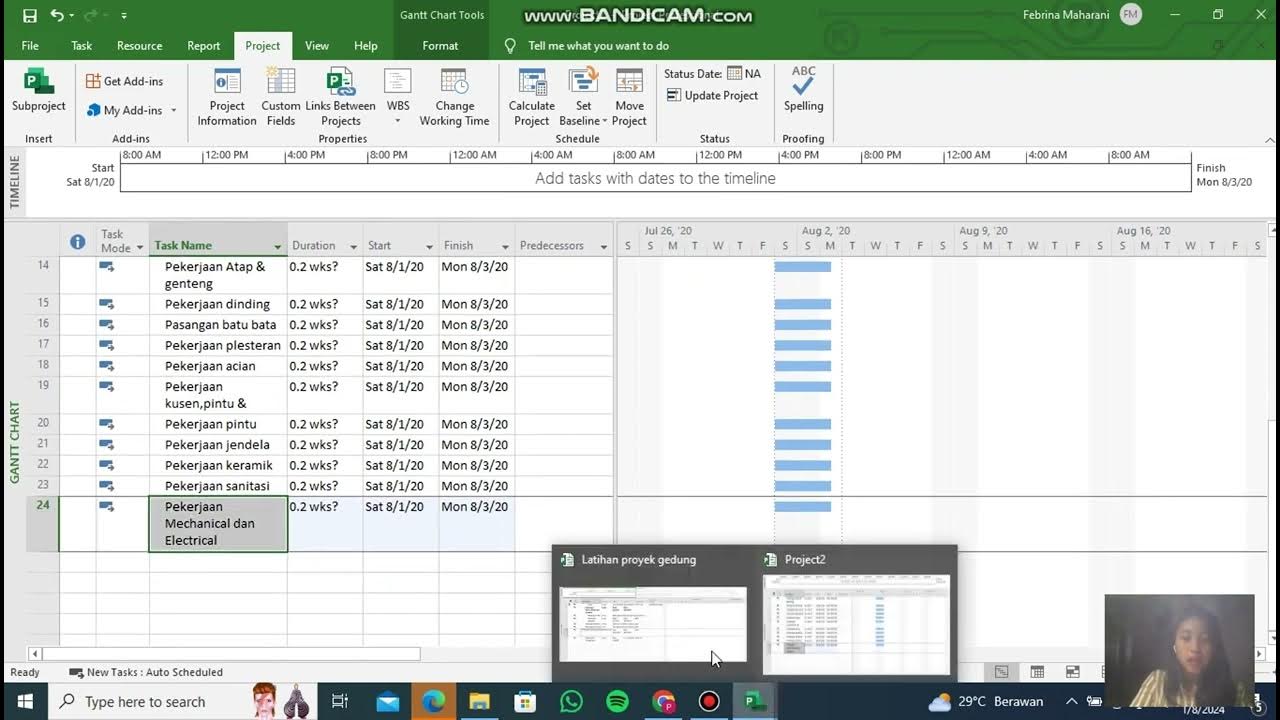01 Penjadwalan Proyek
Summary
TLDRThis video delves into the critical aspects of project scheduling, specifically in construction. It explores how to define organizational goals, plan activities, and develop strategies to ensure timely project completion. Key topics include identifying project activities, determining durations based on available resources, and managing task dependencies. The script also highlights various scheduling tools such as Gantt charts, network planning, and critical path methods. Emphasis is placed on the importance of accurately calculating resource needs, understanding task relationships, and ensuring alignment with contract timelines to ensure successful project execution.
Takeaways
- 😀 Planning is a process that defines organizational goals, develops strategies to achieve them, and creates work plans for project activities.
- 😀 The main objective of project scheduling is to plan and manage the tasks needed to build structures such as buildings, roads, and bridges.
- 😀 Key goals of scheduling include determining task types, establishing relationships between tasks, planning task duration, and defining start and end times for each task.
- 😀 Identifying tasks, estimating their duration, and considering available resources are fundamental for effective project scheduling.
- 😀 Resource management is crucial: project success depends on managing available resources like funds, workforce, materials, and equipment.
- 😀 Productivity calculations are important for estimating how much work can be done per day based on available resources.
- 😀 Task dependencies (i.e., which tasks need to be completed first) must be understood to ensure that work flows logically and efficiently.
- 😀 Adjustments may be necessary if the schedule is unrealistic, either by improving productivity or reassigning resources.
- 😀 Project constraints include budget limitations, deadlines, resource availability, and local factors such as expertise and environment.
- 😀 The Work Breakdown Structure (WBS) is a hierarchical method used to break down a project into smaller, manageable tasks and sub-tasks.
- 😀 Scheduling tools like Gantt Charts, Critical Path Method (CPM), and Network Planning are essential for visualizing task timelines, dependencies, and critical paths in a project.
Q & A
What is the definition of planning in general?
-Planning is the process of defining an organization's goals, developing strategies to achieve these goals, and creating a work plan for the activities of the organization.
How is project scheduling related to planning?
-Project scheduling is a part of planning. It focuses on determining the activities necessary to achieve project goals (e.g., constructing a building or road), defining the sequence of tasks, and determining resource allocation and timelines.
What are the four main objectives of scheduling a project?
-The four objectives are: 1) Identifying the types of activities in a project, 2) Determining the relationships between activities, 3) Planning the duration of each activity, and 4) Determining the start and finish times of activities based on the project timeline.
What factors influence the duration of a task in project scheduling?
-The duration of a task is influenced by available resources such as labor, materials, equipment, and financial capital, as well as the volume of work to be completed.
Why is it important to know the dependencies between tasks in project scheduling?
-Understanding task dependencies is crucial because it helps determine the proper sequence in which tasks must be completed, ensuring that the project flows logically and efficiently.
What are some common tools used in project scheduling?
-Common tools include Gantt charts (Bar Charts), Network Planning, Critical Path Method (CPM), and Line of Balance diagrams.
What is a Work Breakdown Structure (WBS)?
-A Work Breakdown Structure (WBS) is the hierarchical organization of project activities, breaking down the project into smaller, manageable components. It helps organize tasks and defines the relationships between them at different levels.
How does the Gantt chart (Bar Chart) help in project scheduling?
-A Gantt chart visually represents the tasks in a project, showing their start and end dates. It helps to track the progress of activities, allowing project managers to easily identify which tasks are in progress and which ones are pending.
What is the role of resource management in project scheduling?
-Resource management involves determining the necessary resources (labor, equipment, materials) and their availability. Effective resource management ensures tasks are completed within the planned timeframes and with the appropriate quality.
What does the Critical Path Method (CPM) help with in project scheduling?
-The Critical Path Method (CPM) is used to determine the longest sequence of dependent tasks in a project, helping identify the minimum project duration and highlighting tasks that directly affect the project's completion time.
Outlines

This section is available to paid users only. Please upgrade to access this part.
Upgrade NowMindmap

This section is available to paid users only. Please upgrade to access this part.
Upgrade NowKeywords

This section is available to paid users only. Please upgrade to access this part.
Upgrade NowHighlights

This section is available to paid users only. Please upgrade to access this part.
Upgrade NowTranscripts

This section is available to paid users only. Please upgrade to access this part.
Upgrade Now5.0 / 5 (0 votes)





